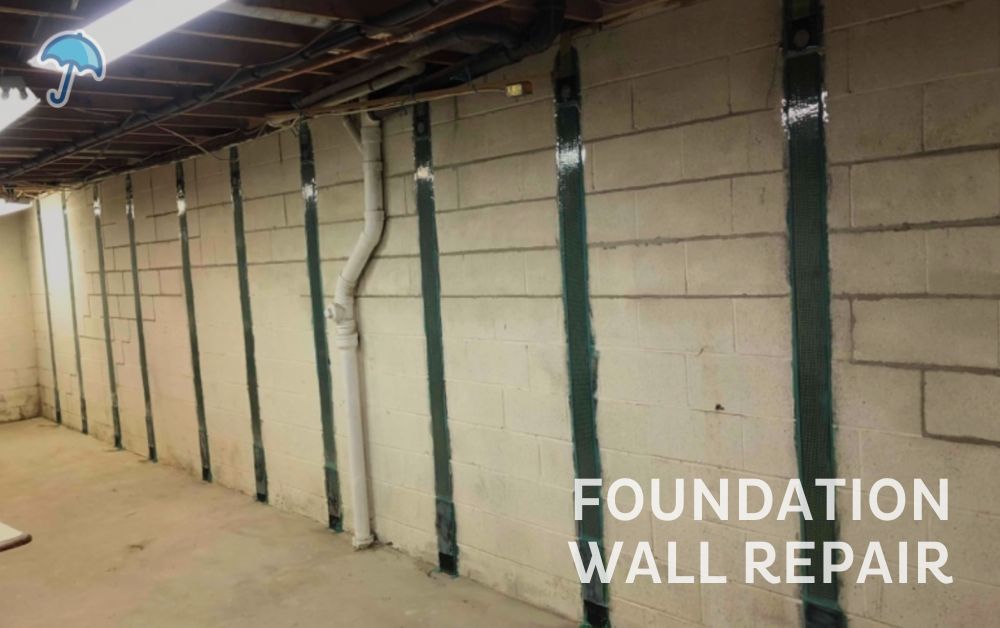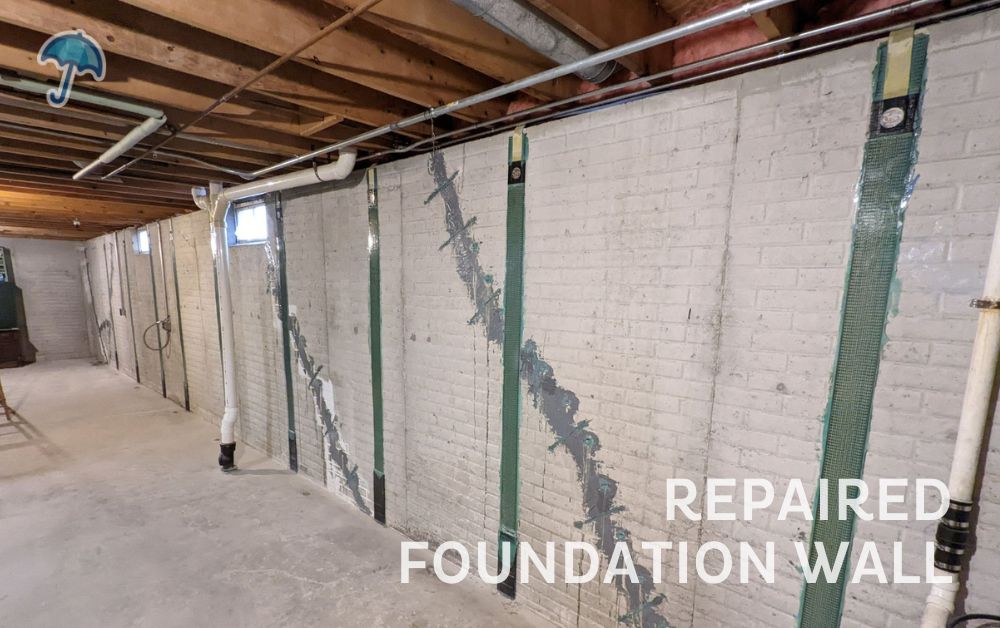New Jersey Shearing Foundation Wall Repair
Shearing Basement Walls Solutions Throughout Central & Northern NJ and the Jersey Shore
Foundation damage is common in New Jersey homes, but just because it's common does not mean you can ignore it. Your foundation supports your whole home, and any damage, including basement wall shearing, is potentially dangerous and needs to be fixed.
As New Jersey's trusted foundation repair company, Blue Umbrella helps you make the best decision for your home's foundation and your budget. With permanent solutions to basement shearing, we are the foundation repair contractor you have been searching for.
But before we jump straight to the solution, let's cover what basement shearing is and what may have caused it in your home.
Suffering From Shearing Foundation Walls?
Contact us today for a free inspection and estimate.
What is Basement Wall Shearing?
Basement wall shearing (foundation wall shearing) is a specific type of cracking and moving of your basement walls. Foundation block walls are built with the bottom row of blocks secured to your basement footing - during initial construction, the pouring of the concrete floor secures or locks the bottom course of block into place.
Essentially the basement concrete floor keeps the bottom of your basement walls from moving in, making this bottom row less moveable than the rest of the wall.
But, given enough external pressure on your foundation, the mortar between the blocks of the bottom row and the row above it can weaken and eventually break - forming a "shear" or “wall shear.”
Over time, the wall shear will worsen, and your foundation wall will continue shifting inward, hanging over the bottom row of blocks. If ignored, the shear will continue to increase until your foundation wall is at risk of collapse!
Though they may seem similar, basement wall shearing differs from basement wall bowing or leaning/tipping.
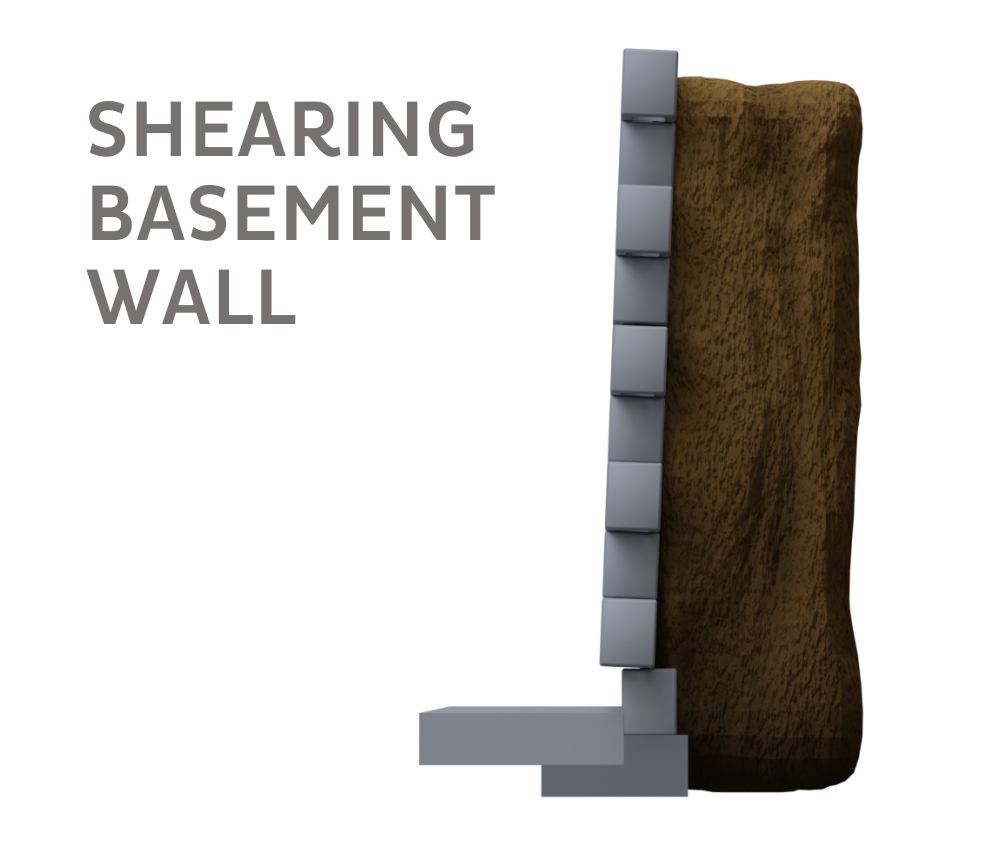
Shearing vs. Bowing vs. Leaning Foundation Walls
Unfortunately, basement shearing is just one type of basement wall issue that you can run into. Basement wall bowing occurs when the center of the basement wall begins to bow inward, curving your basement wall.
And, basement wall leaning/tipping happens when the top of your wall begins to tilt inward. But, whether you are dealing with foundation shearing, bowing, or tipping, all three issues share common causes.
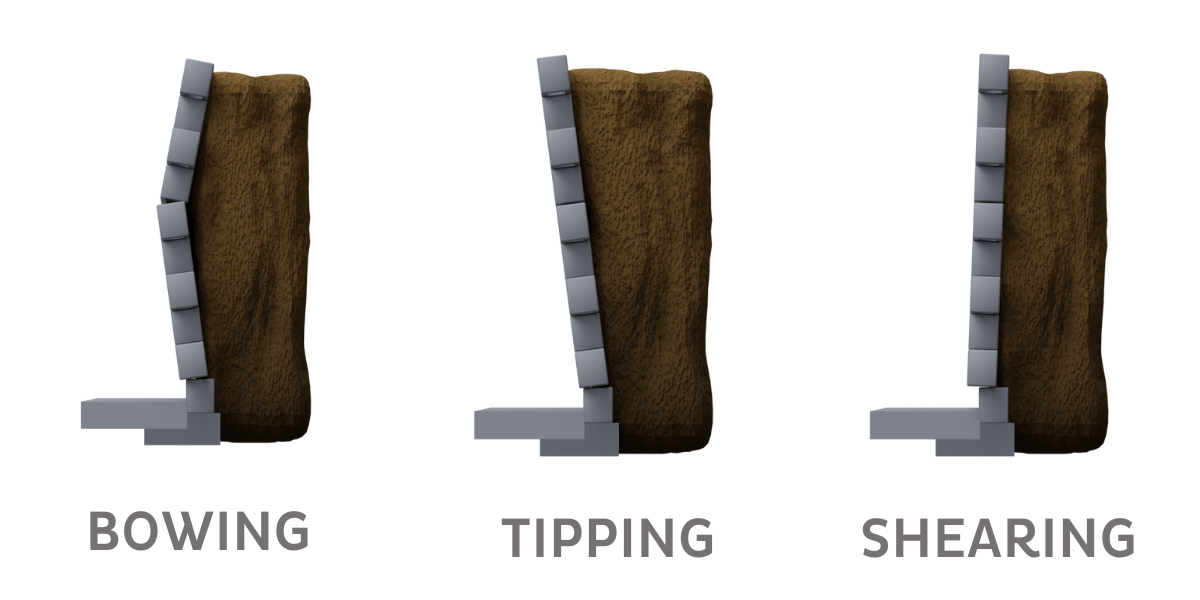
Why is My Basement Wall Shearing?
Your foundation walls were built to primarily withstand the vertical pressure of the weight of your house pressing downwards, also known as dead load. But your foundation also faces problematic lateral pressure from external sources like expansive soil and hydrostatic pressure, which can lead to bowing, tipping, and shearing walls.
On top of that, natural patterns like the frost cycle can also lead to foundation wall shearing. Let's break down each of these common causes in turn.
Expansive Soil
The soil surrounding your foundation applies constant lateral pressure against your basement walls, and specific soil types are more problematic - like New Jersey's high clay-content soil.
When dirt with a high clay concentration gets wet, it expands outward, hence the term expansive soil. As it expands and comes up against your foundation, the additional lateral force pushing your walls inward can cause foundation wall bowing, leaning, and shearing.
Hydrostatic Pressure
Even if the soil around your home doesn't have a high-clay content, the ground can still become water-logged due to heavy rain, poor yard grading, faulty gutters, and inadequate downspouts, all of which create a problem. As the water builds up in the soil, so does hydrostatic pressure, which is the downward force of gravity on the water in the soil.
Water under pressure attempts to move outward to lower-pressure areas, but as the water permeates the soil and comes up against your foundation wall, it cannot continue moving outward. Trapped against your foundation wall, the water pressure increases, straining against your foundation. Eventually, your foundation will start to give, resulting in foundation wall shearing.
Frost
Water in the soil is an even bigger problem in parts of the country that experience harsh winters, like New Jersey. During the winter months, the soil water around your foundation freezes and expands. The expansion applies pressure to your foundation walls creating tiny cracks on the foundation's exterior.
Then, the frost thaws, the water melts away, and the empty cracks are exposed, only to be filled with water left by the next rain or snowfall. When the water freezes a second time, the cracks grow larger. This natural frost, thaw, and crack cycle continues, compromising your basement walls and potentially leading to foundation wall shearing.
It's valuable to understand how expansive soil, hydrostatic pressure, and frost can cause foundation shearing, but the more important question is, do you need to do anything about your shearing foundation walls?
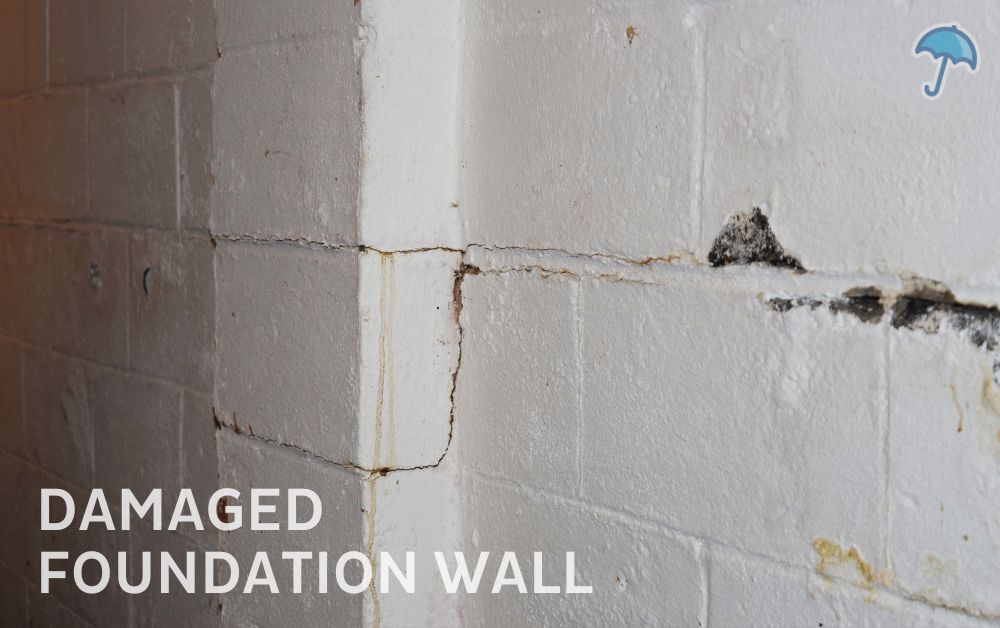
Do I Really Need to Fix Shearing Foundation Walls?
Simply put, yes! Shearing basement walls are a serious problem and must be dealt with immediately.
The cracks in your basement walls caused by foundation shearing may start small but will continue to grow larger until your foundation wall collapses. The failure of one basement wall places more strain on the rest of your basement walls and can lead to the compromise of your entire foundation.
Even without failing, a shearing basement wall can allow outside water to sneak into your basement through the cracks leading to flooding, mold, and mildew. As a result, worsening foundation shearing can lead to you needing foundation repair services and basement waterproofing, which means additional expenses to fix your home.
All of this is why it is so vital that you call Blue Umbrella if you see the start of foundation wall shearing in your basement. The earlier you catch the issue, the less damage there is to fix, and the less expensive the foundation repair. On that note, how exactly do you fix a shearing foundation wall?
How To Fix Shearing Basement Walls
For some of us, when we see that our home is damaged, we feel a sense of personal ownership of the problem and take pride in fixing it ourselves. But when it comes to foundation damage, a DIY attempt at fixing it, while admirable, is not the answer. If done incorrectly, DIY foundation repair not only wastes time and money but can be dangerous both to the long-term health of your home and your own personal safety.
Instead of taking on the task alone, call a trusted New Jersey foundation repair contractor. Call Blue Umbrella to secure and stabilize your shearing foundation wall. To ensure the integrity of your foundation walls, we employ two tested and proven methods to repair shearing basement walls - carbon fiber straps and steel I-beams.
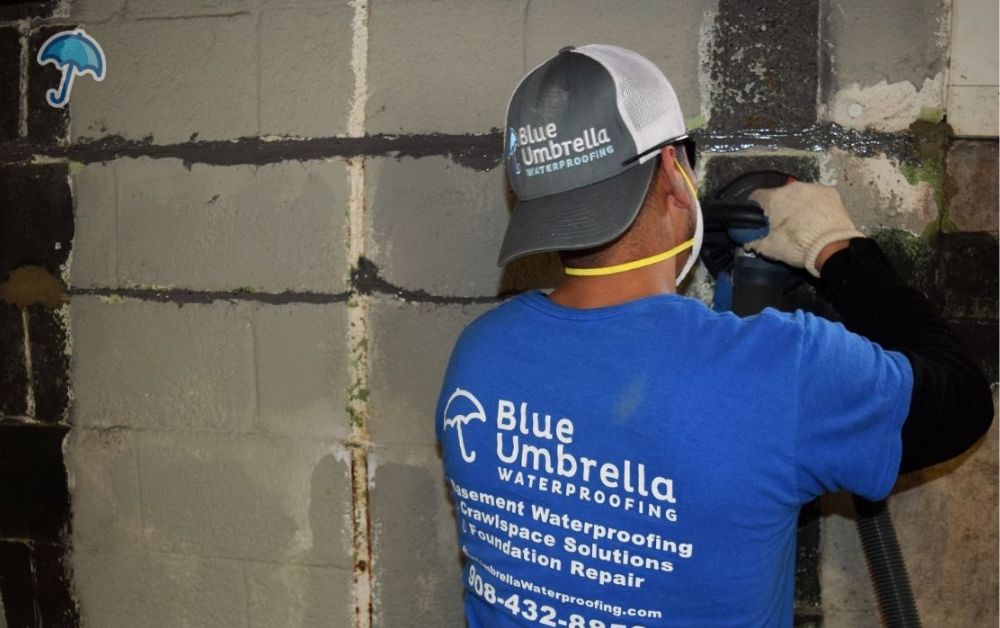
Carbon Fiber Strips (Carbon Fiber Straps)
Blue Umbrella uses Fortress Stabilization Systems' ICC-Building Certified carbon fiber straps to provide complete, reliable repair for sheared, bowed, or tipping basement walls. Our certified carbon fiber straps are the go-to solution for shearing basement walls, as the straps are incredibly effective, minimally invasive, and often the most affordable foundation repair option for New Jersey homeowners.
Our choice of Fortress Stabilization System’s foundation wall reinforcement technology for wall shearing repair is also especially crucial because of the quality of the bottom anchor plate. The bottom anchor plate secures the strap to the bottom of the shearing basement wall and faces the greatest shear force.
Because of this, Fortress Stabilization Systems' bottom anchor plate is made five times thicker and 125 times stiffer than average anchor plates. The addition of a dual-leg solution with specific contact lengths engineered to achieve a 200 percent safety factor makes this bottom anchor and the wall shearing solution the best in the industry.
When Blue Umbrella repairs your shearing foundation walls with industry-best equipment and material you know you are receiving the most reliable, trusted foundation repair solution.
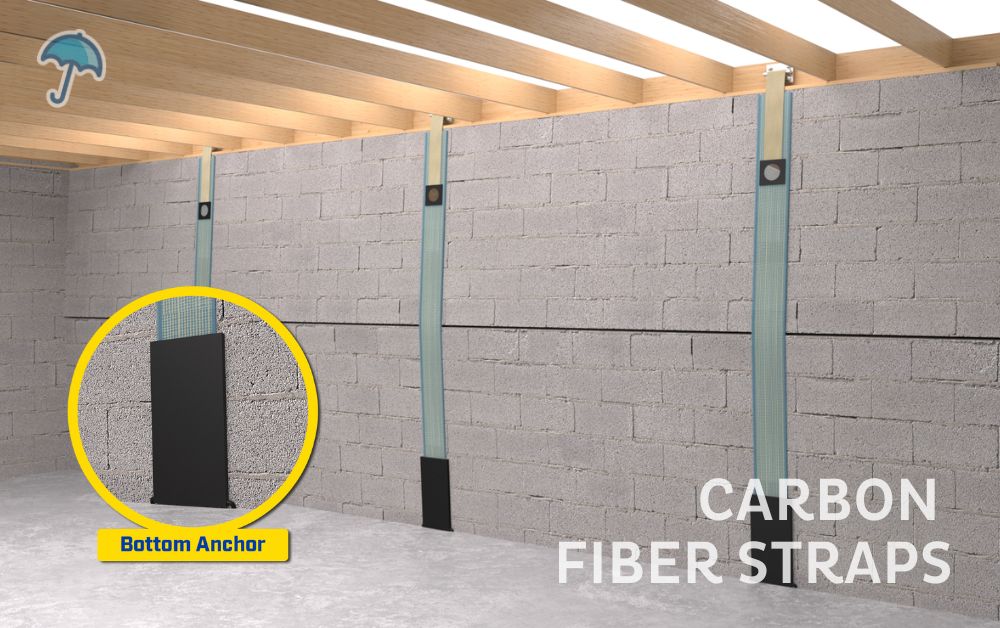
The Carbon Fiber Strap Installation Process
There are six steps we follow when installing carbon fiber straps to your shearing foundation wall.
- Inspect the Basement Walls. First, one of our New Jersey foundation repair experts will inspect your home to determine if carbon fiber straps are the right solution. While this is most likely the case, we always thoroughly check your foundation to ensure no issues prevent installation.
- Installation Planning. We then calculate how many straps are needed to effectively repair your foundation and create a customized foundation repair plan. Before work begins, we sit down with you, explain the procedure, and answer any questions you have.
- Prepare the Wall Surface. Before the straps installing the straps, we prepare the surface of the wall, removing any paint or residue and filling or stitching any existing cracks. This preparation ensures the carbon fiber straps fully adhere to your foundation.
- Place the Straps. After preparation, we place the pre-cured and pre-pregnated straps flush with the foundation wall for a tight seal and apply structural epoxy to bond the straps to the wall.
- Secure the Straps. We then fasten the straps with hangar bolts drilled into the rim joist also called band joist or sill plate about the wall and secure the straps with a solid carbon plate anchor and carbon fiber pin at the bottom.
- Cure the Epoxy. Last, we apply a mylar film to help the epoxy cure. After 24 hours, this film can be removed, and the carbon fiber straps can be painted over if you wish.
With the straps fully installed, your wall is likely stronger than during initial construction, and any further wall shearing is safely prevented.
Steel I-Beams
Although carbon fiber straps are our recommended foundation shearing solution, in some situations, when the foundation shearing has been allowed to grow worse for years and become extreme, we instead recommend steel I-beams.
Like carbon fiber straps, steel I-beams are placed flush against your basement walls and provide the support the wall has lost, preventing additional wall shearing. But steel I-beams can handle more intense foundation damage that carbon fiber straps should not. Installing steel I-beams is similar to the carbon fiber strap installation process.
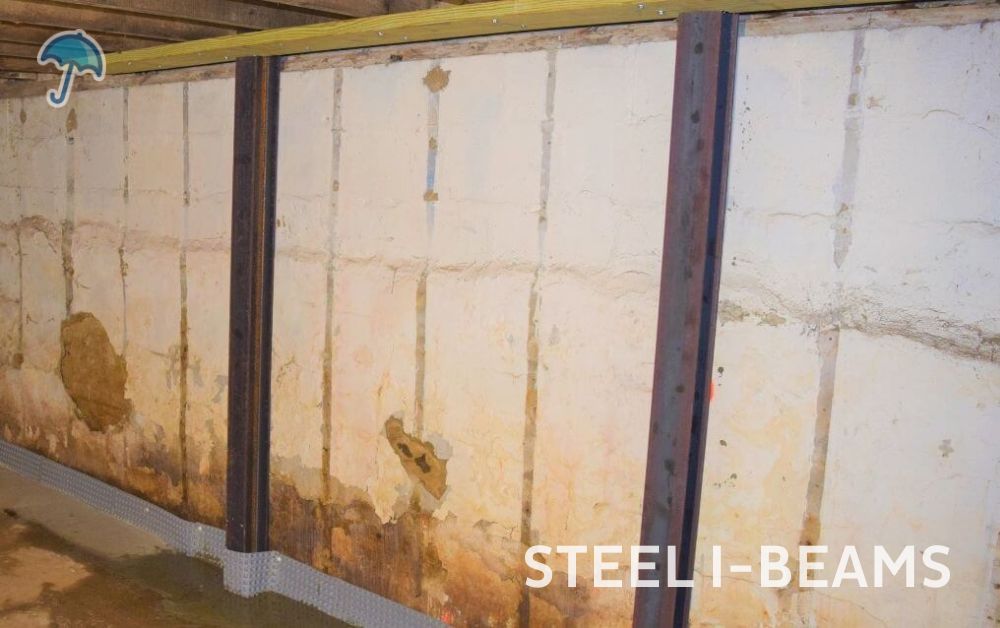
Steel I-Beam Installation Process
- Wall Inspection. We closely examine the walls of your New Jersey home and determine if the shearing has progressed to the point of requiring steel I-beams and that no issues prevent their installation.
- Cut the Beams. We then cut the steel I-beams to ensure the beams fit perfectly between the homes footing and the ceiling of your basement.
- Beam Installation. We install the beams flush against the wall and mount them to a floor plate on the footing and joist bracket for optimum stabilization.
- Potential Trench Digging. For homes without a proper footing, we dig a trench and fill the hole with concrete to form the base for the I-beam.
- Post-Installation Inspection. After installation, we review the work and installation and answer any follow-up questions you may have.
With the I-beams in place, even some of the most intense foundation wall shearing issues can be fixed.
Blue Umbrella Can Repair Your Shearing Basement Wall
So, what is your next step? You know what a shearing basement wall is, its causes, and how it's fixed. Next is calling Blue Umbrella for reliable, permanent foundation repair solutions for shearing foundation walls.
With hundreds of satisfied customers, we are your go-to company for foundation repair in New Jersey. So don't delay; call us today for a free inspection and repair estimate. We can solve your problem.
Have Your Shearing Wall Fixed
Contact us today for a free inspection and estimate.
GET A FREE, NO-OBLIGATION INSPECTION & ESTIMATE
Subscribe to our newsletter for the latest tips, tools & news!
For more information about basement waterproofing services or to find out if Blue Umbrella serves your area, see our complete service area.


